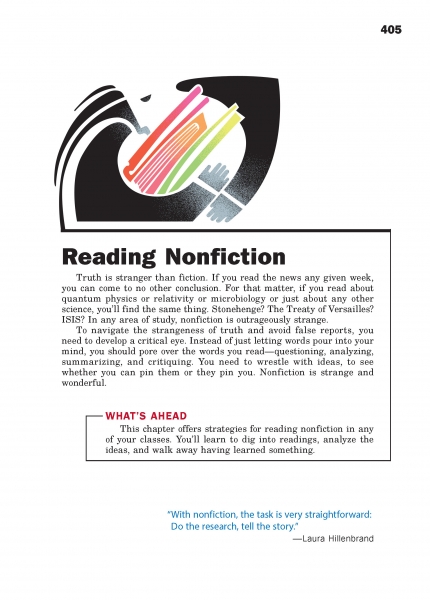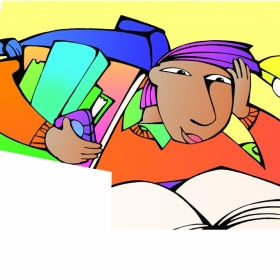Page 405 from

Start-Up Activity
Ask students to describe prehistoric times. They will probably indicate that prehistoric times had dinosaurs or mammoths or Flintstones. Ask students what specific, earthshaking event ended the prehistoric era. They may suggest the asteroid that killed the dinosaurs or the end of the Ice Age.
Let them know that the specific earthshaking event was the creation of writing. When they stare at you incredulously, share with them Webster's first definition of the word prehistoric:
prehistoric: of, relating to, or existing in times antedating written history
Prehistoric literally means "before written history." Once humans started writing things down, they could learn from people far away and long ago. By amassing a vast treasure trove of knowledge and passing it generation to generation, humans have conquered the planet. Throughout human history, the best way to access that trove has been reading.
This chapter helps students read nonfiction, getting their own share of the human treasure.
Think About It
“There's so much more to a book than just the reading.”
—Maurice Sendak

Start-Up Activity
Ask students to describe prehistoric times. They will probably indicate that prehistoric times had dinosaurs or mammoths or Flintstones. Ask students what specific, earthshaking event ended the prehistoric era. They may suggest the asteroid that killed the dinosaurs or the end of the Ice Age.
Let them know that the specific earthshaking event was the creation of writing. When they stare at you incredulously, share with them Webster's first definition of the word prehistoric:
prehistoric: of, relating to, or existing in times antedating written history
Prehistoric literally means "before written history." Once humans started writing things down, they could learn from people far away and long ago. By amassing a vast treasure trove of knowledge and passing it generation to generation, humans have conquered the planet. Throughout human history, the best way to access that trove has been reading.
This chapter helps students read nonfiction, getting their own share of the human treasure.
Think About It
“There's so much more to a book than just the reading.”
—Maurice Sendak



